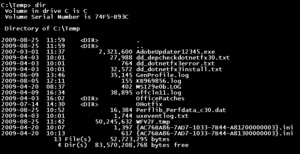
Back مجلد (حوسبة) Arabic Qovluq Azerbaijani Каталог (файлавая сістэма) Byelorussian ডিরেক্টরি (কম্পিউটিং) Bengali/Bangla Directori Catalan Adresář (informatika) Czech Κατάλογος (υπολογιστές) Greek Dosierujo Esperanto Directorio Spanish Kaust (tarkvara) Estonian

In computing, a directory is a file system cataloging structure which contains references to other computer files, and possibly other directories. On many computers, directories are known as folders, or drawers,[1] analogous to a workbench or the traditional office filing cabinet. The name derives from books like a telephone directory that lists the phone numbers of all the people living in a certain area.
Files are organized by storing related files in the same directory. In a hierarchical file system (that is, one in which files and directories are organized in a manner that resembles a tree), a directory contained inside another directory is called a subdirectory. The terms parent and child are often used to describe the relationship between a subdirectory and the directory in which it is cataloged, the latter being the parent. The top-most directory in such a filesystem, which does not have a parent of its own, is called the root directory.
The freedesktop.org media type for directories within many Unix-like systems – including but not limited to systems using GNOME, KDE Plasma 5, or ROX Desktop as the desktop environment – is "inode/directory".[2] This is not an IANA registered media type.
- ^ "Chapter 1: Tutorial". Using The AMIGA Workbench. Commodore-Amiga. July 1991. p. 46.
The path specifies the disk name, or location, and all of the drawers that lead to the specified file.
- ^ Leonard, Thomas (2018-10-02). "Shared MIME-info Database". X Desktop Group. Non-regular files. Retrieved 2023-03-13.